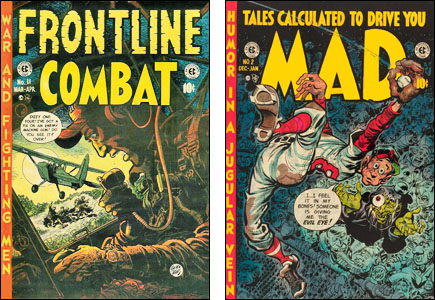I did a bunch of interviews yesterday talking about the late/great Jack Davis, including one for BBC Radio which also ran on NPR here. I'll post a link when I get one.
A point I made in one of them is worth expanding upon here. I always thought there was something neat about the origin of MAD in terms of its original art crew. As you may be aware, MAD started because Harvey Kurtzman was writing and editing — as well as occasionally doing some of the drawing — for two EC war/adventure comics, Frontline Combat and Two-Fisted Tales. Kurtzman was a slow, meticulous worker who carefully researched the stories he wrote, insisting on a degree of historical accuracy that few in comics have ever matched or cared about.
He would also do rough layouts for every panel and he was known to spend days drawing these over and over until he was satisfied they were as good as they could be. That usually turned out to be about three days after when the artist expected the work. Among those who worked with Harvey, there was some disagreement as to whether this was an example of Harvey being a perfectionist or Harvey being one of those neurotic artists who is afraid to ever declare his work "done." Wally Wood, who worked over a lot of those layouts, thought the latter.
In any case, Kurtzman's snail-like pace hurt his income. He was working in a business that paid its talent by the page. More time spent on a page meant fewer pages produced and fewer pages produced meant less income for the creator. Harvey often complained to EC publisher William M. Gaines that this was not fair. Al Feldstein, who wrote and edited EC's horror, crime and science-fiction comics was making three or four times as much money by virtue of producing three or four times as much work.
Gaines reportedly suggested that Kurtzman come up with another comic he could do for the firm — something that wouldn't require a lot of research and that perhaps could be written quicker. There was some disagreement between the two men as to which of them suggested it be a humor comic but somehow, MAD emerged — first in conventional comic book format, then later as a slick magazine. Almost needless to say is that Kurtzman's income did not go up because he spent just as long on a MAD page as he did on Frontline Combat page.

What I always thought was wonderful was this: The art for Kurtzman's war comics was being done by Wally Wood, Will Elder, John Severin and Jack Davis. When it came time to do the funny comic, you'd think he'd have to go out and find different artists…but he didn't. The early issues of MAD were drawn primarily by Wally Wood, Will Elder, John Severin and Jack Davis — and if he had scoured the entire industry and considered everyone who could hold a pen or pencil, he couldn't have done any better.
When I interviewed Davis for my now-outta-print book Mad Art, I suggested to him that that moment was a turning point in his career as an artist. He not only agreed but said, "Well, of course!" It was the first time his "funny" style had been in print — and as good as his more serious illustration was, the humorous Davis style was what made him famous and beloved. In fact, if you now look at his more serious work, he almost looks miscast; like a funny artist got stuck with the wrong material. He did great work in that "wrong" style but you can kinda see his funny side peeking through now and then, here and there, straining to bust out.
In a very real sense, Jack was happy to escape working exclusively in his less cartoony mode. He was never comfy doing the horror comic stories for EC…and wouldn't you know it? They often gave him the most gruesome scripts, figuring that his lighter touch would make things more comedic and therefore more acceptable. One of his most famous horror stories for them — "Foul Play" — involved a baseball game with the parts of a dismembered corpse used for bases, baselines, etc. Its writer-editor Al Feldstein told me, "We crossed the line on that one. We caught hell for it and I can only imagine how bad it would have been if someone other than Jack had drawn it."
That first issue of MAD sixty-four years ago was a real turning point for comics in many ways. One of them was the artistic liberation of Jack Davis.
Jack was, by the way, the last surviving contributor to that issue but for Marie Severin, who did the coloring. A lot of obits about Jack say he was the last surviving EC artist. If you don't count Marie, he was the last of the folks who drew regularly for that line but a few occasional contributors like Russ Heath and Angelo Torres are still with us. Still, it's not inaccurate to say that the passing of Jack Davis represents the passing of an era, as well as the passing of a great artist and a great gentleman.